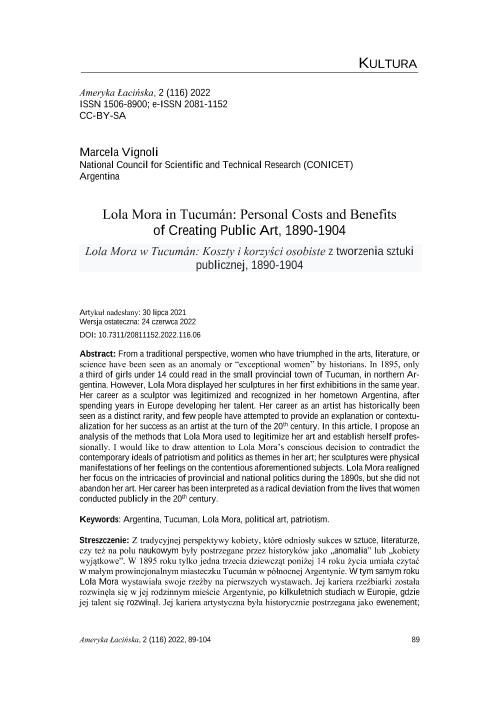Mostrar el registro sencillo del ítem
dc.contributor.author
Vignoli, Marcela

dc.date.available
2023-09-08T11:50:31Z
dc.date.issued
2022-06
dc.identifier.citation
Vignoli, Marcela; Lola Mora in Tucumán: Personal Costs and Benefits of Creating Public Art, 1890-1904; University of Warsaw; Ameryka Łacińska; 2; 116; 6-2022; 89-104
dc.identifier.issn
1506-8900
dc.identifier.uri
http://hdl.handle.net/11336/210875
dc.description.abstract
rom a traditional perspective, women who have triumphed in the arts, literature, or science have been seen as an anomaly or “exceptional women” by historians. In 1895, only a third of girls under 14 could read in the small provincial town of Tucuman, in northern Argentina. However, Lola Mora displayed her sculptures in her first exhibitions in the same year. Her career as a sculptor was legitimized and recognized in her hometown Argentina, after spending years in Europe developing her talent. Her career as an artist has historically been seen as a distinct rarity, and few people have attempted to provide an explanation or contextualization for her success as an artist at the turn of the 20th century. In this article, I propose an analysis of the methods that Lola Mora used to legitimize her art and establish herself professionally. I would like to draw attention to Lola Mora’s conscious decision to contradict the contemporary ideals of patriotism and politics as themes in her art; her sculptures were physical manifestations of her feelings on the contentious aforementioned subjects. Lola Mora realigned her focus on the intricacies of provincial and national politics during the 1890s, but she did not abandon her art. Her career has been interpreted as a radical deviation from the lives that women conducted publicly in the 20th century.
dc.description.abstract
: Z tradycyjnej perspektywy kobiety, które odniosły sukces w sztuce, literaturze, czy też na polu naukowym były postrzegane przez historyków jako „anomalia” lub „kobiety wyjątkowe”. W 1895 roku tylko jedna trzecia dziewcząt poniżej 14 roku życia umiała czytać w małym prowincjonalnym miasteczku Tucumán w północnej Argentynie. W tym samym roku Lola Mora wystawiała swoje rzeźby na pierwszych wystawach. Jej kariera rzeźbiarki została rozwinęła się w jej rodzinnym mieście Argentynie, po kilkuletnich studiach w Europie, gdzie jej talent się rozwinął. Jej kariera artystyczna była historycznie postrzegana jako ewenement; niewiele osób próbowało wyjaśnić lub kontekstualizować jej sukces jako artystki przełomu XIX i XX wieku. W niniejszym artykule proponuję analizę metod, którymi Lola Mora legitymizowała swoją sztukę i ugruntowała swoją pozycję zawodową. Warto zwrócić uwagę, że Lola Mora świadomie kwestionowała ówczesne postrzeganie patriotyzmu; polityka była tematem jej twórczości; rzeźby Loli Mory były fizycznymi manifestacjami jej przekonań politycznych. W latach 90. XIX w. Lola Mora zaangażowana w politykę regionalną i narodową, nie porzuciła swojej sztuki, zaś jej twórczość została zinterpretowana jako radykalne kontestowanie tradycyjnej roli kobiety.
dc.format
application/pdf
dc.language.iso
eng
dc.publisher
University of Warsaw
dc.rights
info:eu-repo/semantics/openAccess
dc.rights.uri
https://creativecommons.org/licenses/by-sa/2.5/ar/
dc.subject
Argentina
dc.subject
Tucumán
dc.subject
Political art
dc.subject
Patriotism
dc.subject.classification
Otras Historia y Arqueología

dc.subject.classification
Historia y Arqueología

dc.subject.classification
HUMANIDADES

dc.title
Lola Mora in Tucumán: Personal Costs and Benefits of Creating Public Art, 1890-1904
dc.title
Lola Mora w Tucumán: Koszty i korzyści osobiste z tworzenia sztuki publicznej, 1890-1904
dc.type
info:eu-repo/semantics/article
dc.type
info:ar-repo/semantics/artículo
dc.type
info:eu-repo/semantics/publishedVersion
dc.date.updated
2023-07-07T17:59:24Z
dc.identifier.eissn
2081-1152
dc.journal.volume
2
dc.journal.number
116
dc.journal.pagination
89-104
dc.journal.pais
Polonia

dc.journal.ciudad
Varsovia
dc.description.fil
Fil: Vignoli, Marcela. Consejo Nacional de Investigaciones Científicas y Técnicas. Centro Científico Tecnológico Conicet - Tucumán. Instituto Superior de Estudios Sociales. Universidad Nacional de Tucumán. Instituto Superior de Estudios Sociales; Argentina. Universidad Nacional de Tucumán. Facultad de Ciencias Naturales e Instituto Miguel Lillo; Argentina
dc.journal.title
Ameryka Łacińska
dc.relation.alternativeid
info:eu-repo/semantics/altIdentifier/url/https://amerykalacinska.com/resources/html/article/details?id=230734
dc.relation.alternativeid
info:eu-repo/semantics/altIdentifier/doi/http://dx.doi.org/10.7311/20811152.2022.116.06
Archivos asociados
